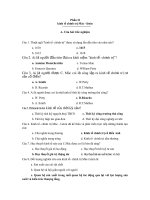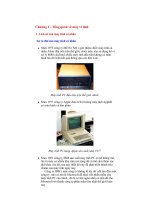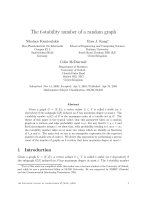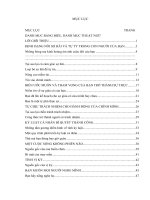PASSAGE 1
Bạn đang xem bản rút gọn của tài liệu. Xem và tải ngay bản đầy đủ của tài liệu tại đây (65.05 KB, 2 trang )
PASSAGE 1
Regulations for the road user at railway level crossing
1. Approach a level crossing at a moderate speed and cross it with care. Do not cross too slowly. Never
drive over it too close to another vehicle. Never drive on to one unless you can see the road is clear on the
other side. Never stop on or immediately beyond any level crossing.
2. Many level crossings have gates operated automatically or by an attendant. Some also have orange
lights followed by flashing red “Stop” lights. Do not pass the lights once they show. If there are no lights
at all, stop when the gates begin to close. .
3. There are some unattended level crossings with gates which road users have to open themselves,
“Stop” signs, and small red and green lights. Do not cross when the red light is showing, as a train is
coming. There is a special railway telephone, and if you are driving a very large or slow-moving vehicle,
or are on foot with animals, you must first telephone the nearest station to make sure it is safe for you to
cross. Open both gates before you cross and close them after you. When you have crossed, telephone the
station to let them know you are over.
4. Some other unattended level crossings have gates but have no red lights. At such crossings, stop, look
both ways, listen and make sure there is no train coming. If there is a special railway telephone, first
telephone to make sure it is safe for you to cross. Before you cross with a vehicle or with animals, open
the gates on both sides wide, and then check once again that no train is coming. Drive your vehicle or
animals right across and well clear of the crossing and then close both gates.
Question 1. All the level crossings described in the passage have __________ .
A. flashing lights
B. attendants
C. telephones
D. gates
Question 2. According to the instructions, you should cross all level crossings __________ .
A. without hesitating
B. in a vehicle
C. as cautiously as possible
D. as far as possible from the car in front
Question 3. You should never drive on to any level crossing if __________ .
A. another vehicle is approaching
B. the exit isn’t clear
C. the attendant has not operated the lights
D. a green light is flashing
Question 4. At a crossing with gates you open yourself you are told to telephone the station if
__________ .
A. a red light is showing
B. your car breaks down close to it
C. you are driving a very large vehicle
D. you have not closed the gates
Question 5. Imagine you are going to drive across an unattended level crossing which has no lights at all.
What is the final thing you must do before actually crossing?
A. Open the near gate wide
B. Look to see if a train is coming
C. Telephone the nearest station
D. Listen for any animals approaching
Page 1
ĐÁP ÁN
1-D
2-C
3-B
4-C
5-B
LỜI GIẢI CHI TIẾT
Question 1:
D. Gates
Thông tin ở đoạn sau: “Many level crossings have ... begin to close.” (Nhiều đường cắt ngang có các cổng
được vận hành tự động hoặc bởi một người phục vụ. Một số cịn có đèn màu cam cùng với ánh sáng đỏ
“Stop”. Đừng vượt qua những đèn này một khi chúng sáng lên. Nếu khơng có đèn nào, hãy dừng lại khi
những cổng này bắt đầu đóng xuống.)
Question 2:
C. as cautiously as possible
Thơng tin ở đoạn sau: “Approach a level crossing ... beyond any level crossing.” (Đi tới một con đường
cắt ngang với tốc độ vừa phải và vượt qua một cách cẩn thận. Đừng đi qua quá chậm. Đừng bao giờ lái xe
qua nó quá gần với các phương tiện khác. Đừng bao giờ đi đến trừ khi bạn có thể nhìn thấy con đường
này rõ ràng ở một phía cịn lại. Đừng bao giờ dừng lại ở trên hoặc ngay trên bất kì con đường cắt ngang
nào.)
Question 3:
B. the exit isn’t clear
Thơng tin ở đoạn sau: “Do not cross too slowly. ... on the other side. “(Đừng đi qua quá chậm. Đừng bao
giờ lái xe qua nó quá gần với các phương tiện khác. Đừng bao giờ đi đến trừ khi bạn có thể nhìn thấy con
đường này rõ ràng ở một phía cịn lại)
Question 4:
C. you are driving a very large vehicle
Thông tin ở đoạn sau: “There is a special railway ... for you to cross.” (Có một đường dây điện thoại
đường sắt đặt biệt, và nếu bạn đang lái một chiếc xe quá lớn hoặc di chuyển quá chậm, hay đang đi bộ với
các con vật, đầu tiên bạn phải gọi điện cho trạm gần nhất để chắc chắn rằng việc đó an tồn để bạn đi qua
được.)
Question 5:
B. Look to see if a train is coming
Thông tin ở đoạn sau: “Some other unattended ... sure there is no train coming.” (Một số đường cắt ngang
khơng có người phục vụ có các cổng nhưng lại khơng có đèn đỏ. Ở các đoạn đường này, hãy dừng lại,
nhìn cả hai bên đường, lắng nghe và chắc chắn rằng khơng có con tàu nào đang tiến đến.)
Page 2








![Moi gioi BAT DONG SAN 01[1].ppt](https://media.store123doc.com/images/document/12/gu/pr/medium_VqscYiF6ld.jpg)
